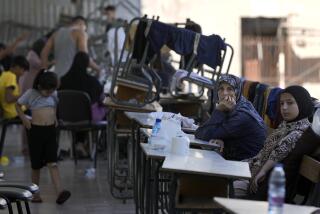As night falls, Haitians head into the streets
- Share via
Reporting from Port-Au-Prince, Haiti — The ritual began just as the soft winter sun ducked behind the mountains Sunday, casting haunting shadows on this jittery Caribbean capital.
Blackened pots bubbled with suppers of rice and beans above glowing charcoal. Sheets, cardboard mats and mattresses were laid neatly on the streets; a lucky few pitched pup tents. Chunks of rubble blocked roads to protect alfresco sleepers from passing motorists.
The magnitude 7.0 earthquake that struck Haiti nearly two weeks ago, and dozens of aftershocks, including a 5.9 temblor at dawn last week, has turned Port-au-Prince into a city deathly afraid of the indoors.
During the day, the people remaining in the capital chip away at crumbled homes, stand in long lines to get money from banks or relatives overseas, scrounge for food and occasionally seek shade in structures still standing.
But at nightfall, the rich and the poor, those with homes and those without, make a giant migration beneath the stars and into the streets. On Sunday, a moderate aftershock at dusk was a gentle reminder of the danger, not that they needed one.
On Rue Daine, a narrow street in the Delmas area, a tight-knit neighborhood of four extended families -- more than 75 people in all -- pitched in Sunday to prepare their street for the night.
A few young women poured water onto the pavement to damp down the powdery white dust. Chairs were moved onto the pavement along with pads, mattresses, sheets and pillows.
Bernadette Millier, 62, was already in her nightgown. (“She’s an early bird,” explained her nephew.) Maxim Auguste was listening to a radio report about efforts to unearth more bodies from the rubble. Ulna Nerdieu was doing her cousin Alice’s hair. And a dozen small children raced around laughing.
“Every time we go inside any house, we’re afraid the earth is going to move,” said Sulface Juslai, 37. His two-story house, home to 30 family members, had collapsed and tilted precariously behind him. His cousin, who had been on the ground floor, was the only person in the building who had died.
Juslai’s biggest concern, and a major worry of everyone on the street, was security -- especially with the collapse of the prisons and the escape of prisoners. A few days earlier, a band of thieves had come to Rue Daine and fired a gun, but the residents ran and nothing was taken.
After that, Juslai and the other adults armed themselves with machetes and began taking turns keeping watch at night. “We don’t sleep well at all,” he said. “We’re too worried.”
Most of the families on Rue Daine have some food, which they share. One family was eating bowls of boiled plantains and rice, which a relief agency had dropped off that day.
Juslai and his family have been eating from their pantry, but the grits they prepared Sunday morning exhausted their supplies. An aunt in Miami has wired money, though, so they plan to join the long line at the money transfer office today.
Near Juslai, a television set sat atop a wooden crate. He said the family brought it out of a neighbor’s house, hoping to watch the global “Hope for Haiti” benefit concert for earthquake victims that aired Friday night, but they hadn’t been able to find a battery to power the set.
The fears of another major temblor are real, even for those in homes that were not damaged by the Jan. 12 quake.
The U.S. Geological Survey issued a preliminary assessment last week, concluding that aftershocks in Haiti are likely to continue for months and possibly years -- and that over the next 30 days the probability of a magnitude 6.0 or greater quake was 1 in 4. The chance of a magnitude 5.0 or greater quake in that period was 90%.
The government has encouraged residents to sleep on the streets until their homes can be tested for structural integrity.
“We all have to take precautions,” said Marie-Laurence Jocelyn Lassegue, the culture and communications minister. “If you are sleeping in the street, stay together. We’ll do our best to get tests very soon.”
“Our priority is food and water,” she said. “But what people need most is to be in their homes and not on the street.”
On Rue Daine, Juslai’s neighbor Jean Lafaille, 58, was sitting on a sofa on the road Sunday, feeding spoonfuls of a rice stew to two shirtless toddlers, the youngest of his 12 children.
“It’s difficult to be like this,” Lafaille said. “This is the first time in our lives that we’ve had to live on the street.”
More to Read
Sign up for Essential California
The most important California stories and recommendations in your inbox every morning.
You may occasionally receive promotional content from the Los Angeles Times.











